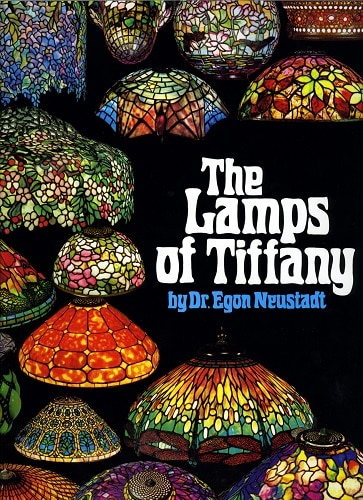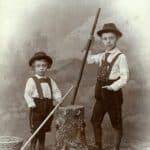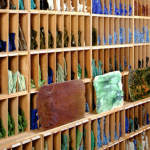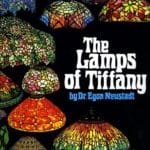An amateur poet, Dr. Neustadt wrote a sentimental poem entitled “The Choicest Lamp” that he included as the preface to his landmark 1970 publication, The Lamps of Tiffany.
The Choicest Lamp
We passed a tiny basement store,
Walked down a wooden ramp
And soon her eager eyes did spot
A strange, old-fashioned lamp.
She took me there a second time,
Entreating all the while;
The lamp was no more radiant
Than her excited smile.
At home, it soon found company
And fathered a collection
In styles of every form and size,
Of color and complexion.
When experts argue which of them
The choicest lamp may be,
I keep my peace because I know
Which one it is – for me.
Dr. Egon Neustadt (1898-1984) and his wife Hildegard (1910-1961) were Austrian immigrants who were among the earliest collectors of works by American artist Louis C. Tiffany (1848-1933). The Neustadts bought their first Tiffany lamp from a second-hand shop in Greenwich Village in 1935 when Tiffany’s designs were out of fashion and at odds with popular tastes. Newly married, they were decorating their home in Flushing, Queens, when they stumbled upon a colorful stained-glass Daffodil lamp. Enamored of all things American, they were delighted to learn that the beautiful lampshade was made in the country they now proudly called home.
An interview with Director and Curator of The Neustadt Collection of Tiffany Glass
Lindsy Parrott provides extraordinary insight into the collectors and their passion for the beauty of Tiffany glass.
Can you give us an idea of the size and scope of Dr. Neustadt’s collection of Tiffany Lamps?
Over the course of fifty years of collecting, Dr. Neustadt built a renowned collection of more than 200 Tiffany lamps, in addition to Tiffany windows, desk set accessories, and a trove of flat glass and glass “jewels” used by Tiffany Studios. It remains the largest and most significant collection of Tiffany lamps ever assembled. He founded the museum (originally named the Egon & Hildegard Neustadt Museum of Tiffany Art; and known today as The Neustadt Collection of Tiffany Glass) in 1969, and he displayed in the rooms of his townhouse on the Upper East Side of Manhattan. In 1983, he exhibited approximately 130 lamps at the New-York Historical Society and donated them following the exhibition.
Today, the holdings of The Neustadt Collection of Tiffany Glass fall into three main categories: lamps, windows, and an archive of more than a quarter of a million examples of flat and pressed glass. As a result, we focus primarily on leaded-glass objects. The collection includes more than 100 Tiffany lamps, with about 25 additional Tiffany lamp bases which allow us to “mix and match;” an option that Tiffany’s clients also had when purchasing a lamp.
A word about scope: The Neustadts aspired to build an encyclopedic collection of Tiffany’s leaded-glass lampshades – one that highlighted the range of sizes, shapes, and decorative motifs produced by Tiffany Studios. From reading lamps to library lamps, floor lamps to hanging shades, geometric patterns to floral designs, the Neustadts collection captures the staggering diversity of Tiffany’s lamps.
Also of note, we have a vitally important study collection of approximately 50 early lamp forgeries, which attests to the growing interest in Tiffany’s work – and its’ increased value in the marketplace – during the 1970s and 1980s. Dr. Neustadt was probably fooled by these forgeries: some of them are exceptionally beautiful and well-made. During this time, Tiffany scholarship was in its infancy – there were no reference books or museum collections to guide Dr. Neustadt. He was learning as he went. Like many collectors ahead of their time, he invariably made some mistakes along the way.
When did the Neustadts know their love of Tiffany was turning into a large collection?
By 1960, the Neustadts had collected over 100 works by the Tiffany Studios. The majority of the objects were lamps, but they had also acquired approximately a dozen
leaded-glass windows by this time.
In the late 1960s or 1970s, Dr. Neustadt balked at a $4,000 price tag for a Wisteria lamp (now in our collection) that is often referred to as the “sunset Wisteria” because of the pinkish color of the background glass, calling the price “fantastic” since they were selling for around $2,000 at that time. After several weeks of pining and unsuccessful negotiating, Dr. Neustadt eventually caved and paid the asking price. Today, that $4,000 would be a steal: in the last few years, Wisteria lamps have sold at auction for between $350,000 and $1.5 million.
How far around the planet did they go to purchase lamps?
Collecting seems to have been confined to the tri-state area. Dr. Neustadt describes roaming Greenwich Village, attending auctions, and spending one day each week visiting shops dealing in this material. He worked closely with dealers. The Neustadts spent time, too, scouring second-hand shops and antique stores in the areas surrounding the Connecticut country house.
What story does the collection tell?
The collection tells the story of the design, artistry, and craftsmanship of Tiffany Studios’ lamps. It also tells a story of connoisseurship – the idea of “good, better, best” – because the Neustadts purchased multiple examples of many of the lamps. These multiples, for example, allow us to talk about the important role of glass selection and how these color and texture choices impact the finished object.
Who were his favorite shade designers and why?
Dr. Neustadt doesn’t seem to have been focused on any particular designers. It’s important to remember that renewed interest in Tiffany’s artistic career was just beginning in the late 1950s and continued to mount in the 1960s and 1970s. Early Tiffany scholar Robert Koch credited some of Tiffany’s most important designers-Frederick Wilson, Agnes Northrop, Clara Driscoll-so their names were known, but collectors, including the Neustadts, don’t seem to have been particularly focused on them. That said, the Neustadts purchased important examples of some of Driscoll’s most beloved lamp designs: numerous examples of the Dragonfly shade, a superb example of the Butterfly shade, multiples of the Wisteria lamp, an example of the Cobweb shade with mosaic base, etc.
What is the rarest item in the collection?
The rarest item in the lamp collection is also one of everyones favorites: a one-of-a-kind leaded-glass shade decorated with a swarm of small dragonflies. Dr. Neustadt purchased this special lamp from Lillian Nassau, the renowned Manhattan gallery specializing in the work of Tiffany Studios. The shade was suspended from three chains, but based on the bronze collar encircling the top edge of the shade, it is likely that it was originally flush mounted to the ceiling (clipped into some sort of mounting bracket). Lillian Nassau sold the lamp to Dr. Neustadt as a hanging shade and we continue to display it this way.
What were Dr. Neustadt’s favorite lamps?
Among his favorite lamps, and he clearly prized different lamps for different reasons (rarity, visual appeal, etc.), is the first one he and Hildegard acquired: a small Daffodil shade. It is an exquisite example-rather understated, but the glass selection is beautiful – and he kept it on or close to his desk throughout his life.
What kind of feedback do you get from the public when they see the collection?
I often hear audible gasps when people tour of exhibitions, and even when I give illustrated lectures on the collection. I think people are so bombarded with examples of mass-produced Tiffany-style lamps that they think they “know” Tiffany lamps. But when they see authentic examples in person, they are bowled over by the wonderful designs, richly colored glass, and exceptional craftsmanship of the shades and bases.
What are your plans for the newly discovered personal notes of Dr. Neustadt?
We recently discovered a significant portion of Dr. Neustadt’s handwritten memoir buried in some old files. It has provided fascinating insights into his personal history, which we knew very little about. It has also given us a real sense of Dr. Neustadt’s personality and I am impressed by his cleverness, sense of humor, boundless determination, and incredible professional success.
His writings fill in a lot of holes about his family and life in Vienna, his professional life and hobbies, and how and why he came to America. We are also planning a publication exploring the Neustadts and their collecting legacy, which will give us an opportunity to include more of the stories featured in Dr. Neustadt’s memoirs.
As curator, what do you feel it is that continues to draw people to these lamps and adding them in their own home or collection?
People continue to be drawn to the undeniable beauty of the lamps. Tiffany Studios advertised the lamps as being both useful and beautiful and that combination still appeals to people today.
About Lindsy Parrott
Lindsy R. Parrott is the Director and Curator of The Neustadt Collection of Tiffany Glass. During her thirteen year tenure, her research has centered on Louis C. Tiffany’s leaded-glass windows, lamps, and opalescent flat glass. Currently, Ms. Parrott is co-curating the upcoming special exhibition “Tiffany’s Glass Mosaics,” organized jointly by The Corning Museum of Glass and The Neustadt Collection of Tiffany Glass, and is the co-editor as well as a contributor to the accompanying publication.
About The Neustadt Museum
Dedicated to preservation, scholarship, education, and connoisseurship, The Neustadt Collection of Tiffany Glass provides an in-depth look at the artistry of Tiffany Studios and its contribution to a uniquely American chapter in the history of stained glass. The organization is committed to sharing this story and its collections with diverse audiences through its gallery at the Queens Museum and exhibitions that travel to museums nationwide. For more information visit neustadtcollection.org.

















Related posts: